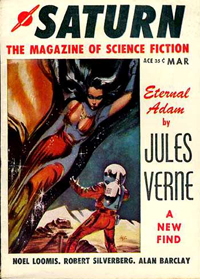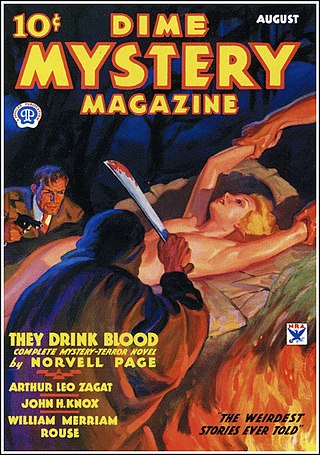Pulp magazines were inexpensive fiction magazines that were published from 1896 until around 1955. The term "pulp" derives from the cheap wood pulp paper on which the magazines were printed. In contrast, magazines printed on higher-quality paper were called "glossies" or "slicks". The typical pulp magazine had 128 pages; it was 7 inches (18 cm) wide by 10 inches (25 cm) high, and 0.5 inches (1.3 cm) thick, with ragged, untrimmed edges. Pulps were the successors to the penny dreadfuls, dime novels, and short-fiction magazines of the 19th century.

Gold Medal Books, launched by Fawcett Publications in 1950, was an American book publisher known for introducing paperback originals, a publishing innovation at the time. Fawcett was also an independent newsstand distributor, and in 1949 the company negotiated a contract with New American Library to distribute their Mentor and Signet titles. This contract prohibited Fawcett from publishing their own paperback reprints.

Fiction House was an American publisher of pulp magazines and comic books that existed from the 1920s to the 1950s. It was founded by John B. "Jack" Kelly and John W. Glenister. By the late 1930s, the publisher was Thurman T. Scott. Its comics division was best known for its pinup-style good girl art, as epitomized by the company's most popular character, Sheena, Queen of the Jungle.

Martin Goodman was an American publisher of pulp magazines, digest sized magazines, paperback books, men's adventure magazines, and comic books, who founded the comics magazine company Timely Comics in 1939. Timely Comics would go on to become Marvel Comics, one of the United States' two largest comic book publishers along with rival DC Comics.
Popular Publications was one of the largest publishers of pulp magazines during its existence, at one point publishing 42 different titles per month. Company titles included detective, adventure, romance, and Western fiction. They were also known for the several 'weird menace' titles. They also published several pulp hero or character pulps.

A. A. Wyn was an American publisher.
Lancer Books was a publisher of paperback books founded by Irwin Stein and Walter Zacharius that operated from 1961 through 1973. While it published stories of a number of genres, it was noted most for its science fiction and fantasy, particularly its series of Robert E. Howard's Conan the Barbarian tales, the first publication of many in paperback format. It published the controversial novel Candy by Terry Southern and Mason Hoffenberg, and Ted Mark's ribald series The Man from O.R.G.Y. Lancer paperbacks had a distinctive appearance, many bearing mauve or green page edging.
Ace Magazines was a comic book and pulp-magazine publishing company headed by Aaron A. Wyn and his wife Rose Wyn. The Wyns had been publishing pulp fiction under the Periodical House and A. A. Wyn's Magazine Publishers names since 1928, and published comics between 1940 and the end of 1956.

Dan Dunn is a fictional detective created by Norman W. Marsh. He first appeared in Detective Dan: Secret Operative No. 48, a proto-comic book from 1933, produced by Humor Publishing. He subsequently appeared in newspaper comic strips from 1933 to 1943.

Secret Agent X was the title of a U.S. pulp magazine published by A. A. Wyn's Ace Magazines, and the name of the main character featured in the magazine. The magazine ran for 41 issues between February 1934 and March 1939.

Saturn was an American magazine published from 1957 to 1965. It was launched as a science fiction magazine, but sales were weak, and after five issues the publisher, Robert C. Sproul, switched the magazine to hardboiled detective fiction that emphasized sex and sadism. Sproul retitled the magazine Saturn Web Detective Story Magazine to support the change, and shortened the title to Web Detective Stories the following year. In 1962, the title was changed yet again, this time to Web Terror Stories, and the contents became mostly weird menace tales—a genre in which apparently supernatural powers are revealed to have a logical explanation at the end of the story.
The Moon Man is a fictional pulp magazine character who appeared in Ten Detective Aces magazine, published by A.A. Wyn's Ace Magazines. He was a pulp hero in the Robin Hood mold. Frederick C. Davis (1902–1977) created the character and wrote all the original stories under his own name. Davis, who after his time as a pulp writer had a long career as a mystery novelist, generally wrote under various pen names.

Alden Spurr McWilliams generally credited as Al McWilliams and A. McWilliams, was an American comics artist who co-created the first African-American lead character of a comic strip. He won the National Cartoonists Society's 1978 award for Comic Book: Story.

Scientific Detective Monthly was a pulp magazine that published fifteen issues beginning in January 1930. It was launched by Hugo Gernsback as part of his second venture into science-fiction magazine publishing, and was intended to focus on detective and mystery stories with a scientific element. Many of the stories involved contemporary science without any imaginative elements—for example, a story in the first issue turned on the use of a bolometer to detect a black girl blushing—but there were also one or two science fiction stories in every issue.

War Birds was a pulp magazine published by Dell from 1928 to 1937. It was the first pulp to focus on stories of war in the air, and soon had competitors. A series featuring fictional Irishman Terence X. O'Leary, which had started in other magazines, began to feature in War Birds in 1933, and in 1935 the magazine changed its name to Terence X. O'Leary's War Birds for three issues. In these issues the setting for stories about O'Leary changed from World War I to the near future; when the title changed back to War Birds later that year, the fiction reverted to ordinary aviation war stories for its last nine issues, including one final O'Leary story. The magazine's editors included Harry Steeger and Carson W. Mowre.

Ace Mystery was a weird menace pulp magazine which published three issues starting in 1936, followed by two more under the title Detective Romances.

Dime Mystery Magazine was an American pulp magazine published from 1932 to 1950 by Popular Publications. Titled Dime Mystery Book Magazine during its first nine months, it contained ordinary mystery stories, including a full-length novel in each issue, but it was competing with Detective Novels Magazine and Detective Classics, two established magazines from a rival publisher, and failed to sell well. With the October 1933 issue the editorial policy changed, and it began publishing horror stories. Under the new policy, each story's protagonist had to struggle against something that appeared to be supernatural, but would eventually be revealed to have an everyday explanation. The new genre became known as "weird menace" fiction; the publisher, Harry Steeger, was inspired to create the new policy by the gory dramatizations he had seen at the Grand Guignol theater in Paris. Stories based on supernatural events were rare in Dime Mystery, but did occasionally appear.

Operator #5 was a pulp magazine published between 1934 and 1939.

G-8 and His Battle Aces was an American air-war pulp magazine published from 1930 to 1944. It was one of the first four magazines launched by Popular Publications when it began operations in 1930, and first appeared for just over two years under the title Battle Aces. The success of Street & Smith's The Shadow, a hero pulp, led Popular to follow suit in 1933 by relaunching Battle Aces as a hero pulp: the new title was G-8 and His Battle Aces, and the hero, G-8, was a top pilot and a spy. Robert J. Hogan wrote the lead novels for all the G-8 stories, which were set in World War I. Hogan's plots featured the Germans threatening the Allied forces with extraordinary or fantastic schemes, such as giant bats, zombies, and Martians. He often contributed stories to the magazines as well as the lead novel, though not all the short stories were by him. The cover illustrations, by Frederick Blakeslee, were noted for their fidelity to actual planes flown in World War I.

Battle Birds was an American air-war pulp magazine, published by Popular Publications. It was launched at the end of 1932, but did not sell well, and in 1934 the publisher turned it into an air-war hero pulp titled Dusty Ayres and His Battle Birds. Robert Sidney Bowen, an established pulp writer, provided the lead novel each month, and also wrote the short stories that filled out the issue. Bowen's stories were set in the future, with the United States menaced by an Asian empire called the Black Invaders. The change was not successful enough to be extended beyond the initial plan of a year, and Bowen wrote a novel in which, unusually for pulp fiction, Dusty Ayres finally defeated the invaders, to end the series. The magazine ceased publication with the July/August 1935 issue. It restarted in 1940, under the original title, Battle Birds, and lasted for another four years. All the cover art was painted by Frederick Blakeslee.















